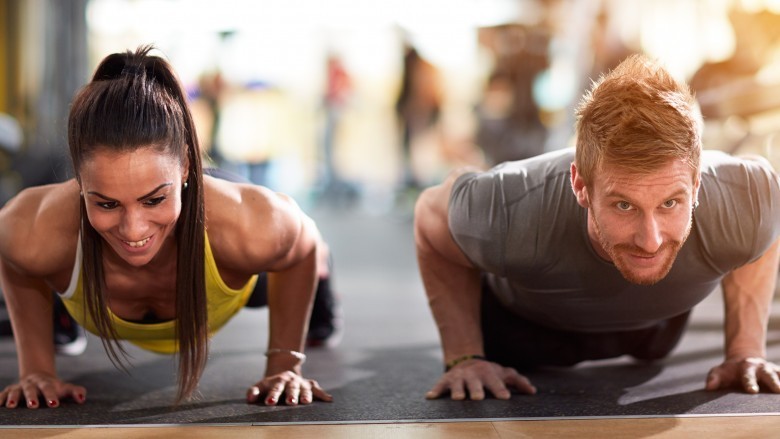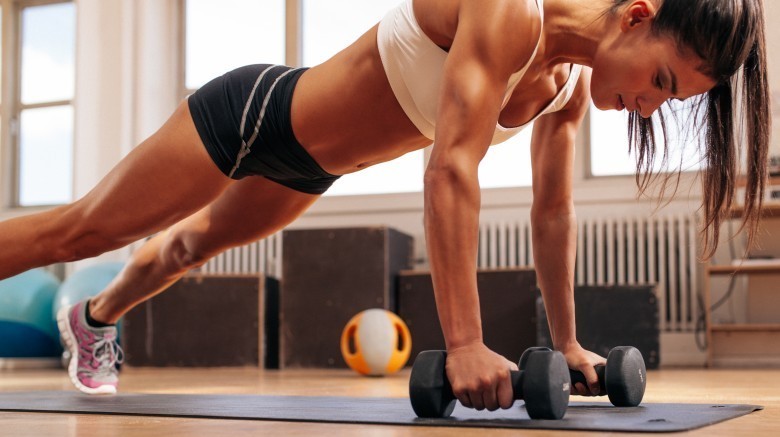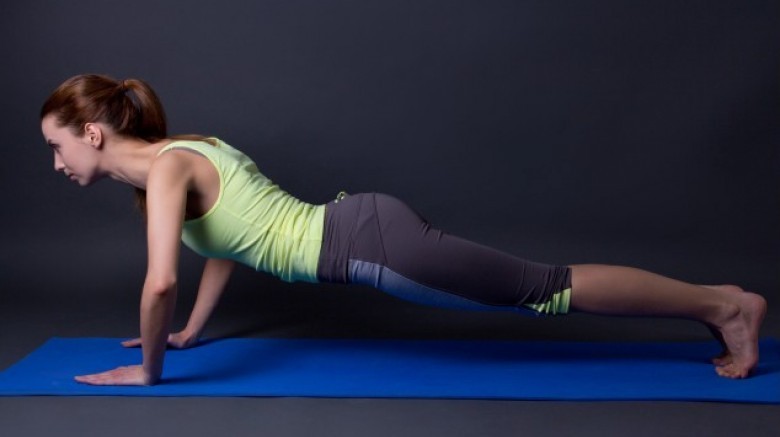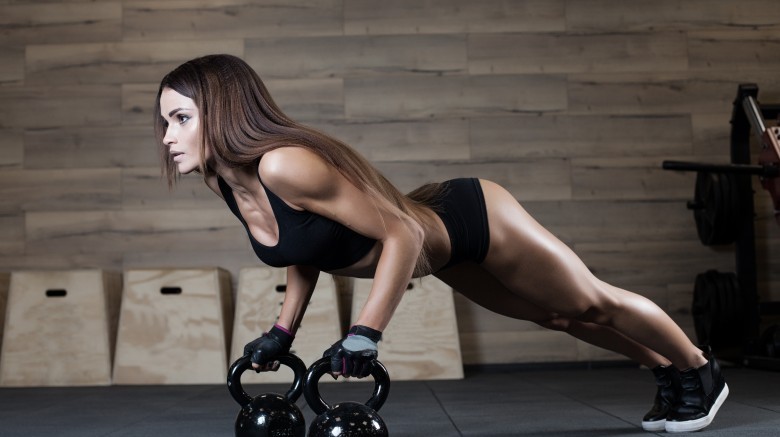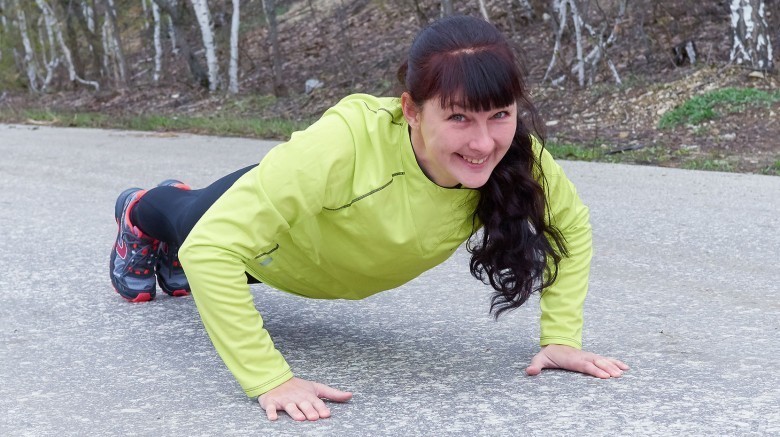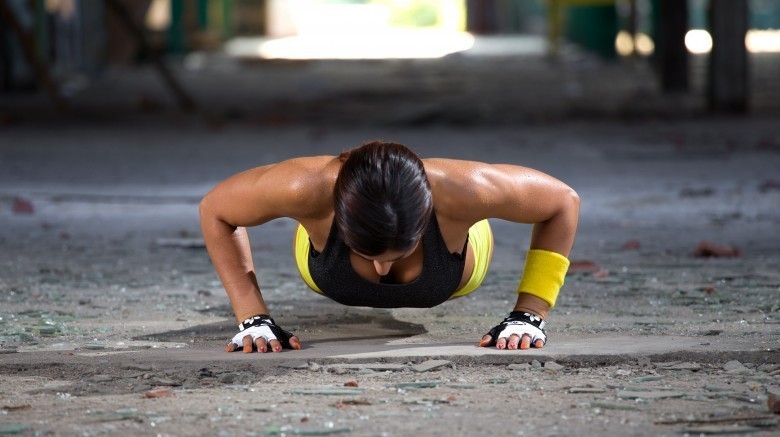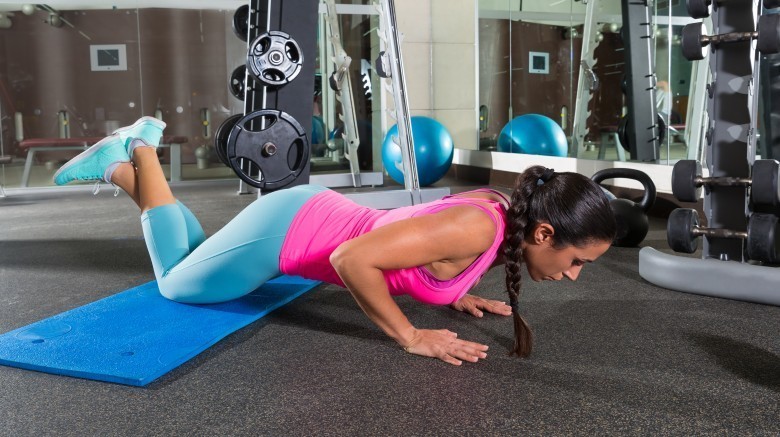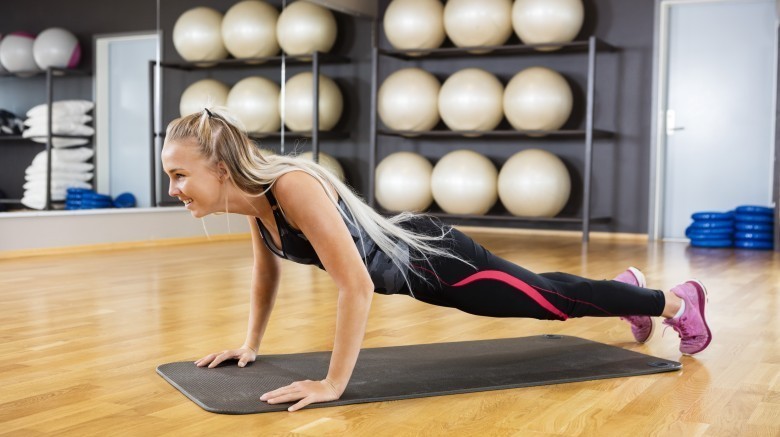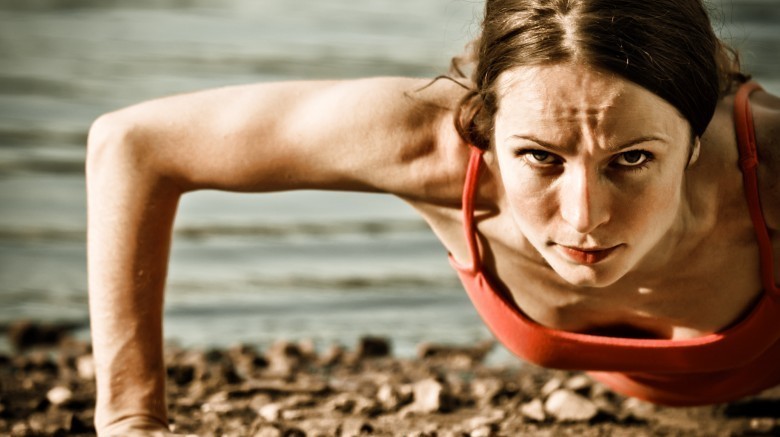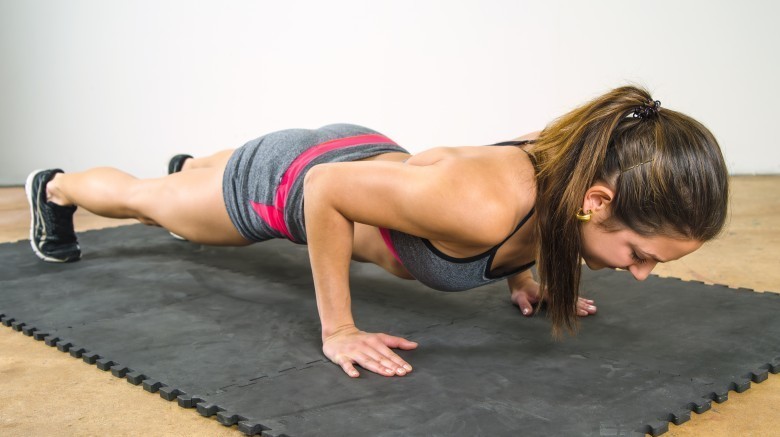10 Pushup Mistakes You're Probably Making
You've probably been doing some form of pushup since elementary school P.E. class, so of course you know how to do one correctly, right? Well, maybe not! If I've learned anything from my 15-plus years in the fitness industry, it's that most people are terrible at performing bodyweight exercises like pushups with proper form. And I'm not the only one who's noticed this.
"In general, I would say the majority of people don't know how to do a pushup," says Diana Mitrea, a New York City-based personal trainer who teaches group fitness classes at Equinox, "I spend a lot of time coaching this in my classes, and most people share the same mistakes." So rather than fall into the same category as "most people," learn to identify your weaknesses so you can rock a perfect pushup with proper form.
Your hand placement is all wrong
When it comes to proper pushup form, it all starts with proper hand placement. According to Mitrea, most people place their hands too wide and too far forward, "This puts more pressure on the shoulders, and you end up not having full pushup power."
Check your form by making sure the heel of each palm is directly under each shoulder, just slightly wider than chest-width apart. This provides a sturdy base of support for the exercise without placing undue stress on the shoulder joints.
You let your elbows flare
An all-too-frequent byproduct of incorrectly placed hands, along with a misunderstanding of what a pushup is supposed to look like (many people assume your body should form a "T" shape with your arms jutting out at 90-degree angles from the body), is the second pushup sin: flared elbows.
Chris Clough, an NSCA certified personal trainer refers to this as "flying elbows," and explains that this type of poor alignment results in additional stress placed on the shoulders. Placing your hands in the correct position helps, making sure your wrists aren't angled inward or outward, but rather neutrally aligned with your middle finger pointing straight ahead. But that's not all. Clough suggests checking your elbows to ensure they're pointing back at roughly 60-degree angles from your body, turning your body shape into more of an arrow than a "T."
You drop or crane your head
Many people are so concerned with the actual act of completing a pushup, they forget that a big part of the exercise is maintaining spinal alignment. This rears its ugly head in many ways, but one of the most common is the tendency to actually rear your head.
People occasionally forget that their neck is part of their spine, and, inevitably, when the exercise gets tough, neck alignment is the first thing to go. Mitrea chalks this tendency up to cheating, saying, "I see this a lot when people lack pushup strength — they stick their neck out to feel like they're getting closer to the ground." Unfortunately, it just strains your neck, doing nothing for your upper body strength. Focus on keeping your neck completely neutral, with your eyes on the ground, to help prevent yourself from looking up.
You let your lower back sag
Right after your neck drops between your arms, your lower back probably starts to sag. It's the inevitable form breakdown that takes place when you just don't have the baseline strength necessary to perform a standard pushup.
Clough points specifically to poor core strength as the culprit for this "swayback." And if you're not careful, your sway could result in an unfortunate bout of lower back pain. Instead of gutting through a few more reps with poor form, Clough says, "Try inclined pushups with an emphasis on bracing your core as you begin the pushups." Simply place your hands on a raised surface, like a counter, bench, or sturdy chair to give the exercise another go.
You press your hips toward the ceiling
A slightly less common (and less problematic) pushup mistake is the tendency to press your hips up toward the ceiling. While this is certainly a cheat move that makes the exercise easier by requiring less core engagement, it's less likely to result in pain or injury than the more common swayback.
Meghan Kennihan, an NASM-certified personal trainer points out that you're really just losing out on an opportunity to work your abs, advising, "Pushups are a great ab exercise, but if you look like an upside-down 'V,' you're not engaging your abs. Use your glute muscles and squeeze: this will help you lower your butt and return your body to its proper alignment."
You don't work through a full range of motion
Ladies, I'm sorry, but this is probably the most common mistake I personally see: you just don't do a full pushup. Instead, you hang out at the top of the exercise, doing little "pulses" while you pretend you're logging a slew of "big girl" pushups. You're not. You're cheating.
Tricia Brouk, the owner-director of Brouk Moves agrees. "People kid themselves when they think tiny bends and straightening of the elbows in a full plank is a pushup. It's not. Slow, full range of motion pushups are what increase strength and stamina. If you have a perfect plank, but you cannot bend your arms to 90-degrees and straighten them back fully, you need to modify your pushups by doing them on your knees. One solid, perfect pushup will serve you far better than 50 small pulses."
You pump out reps too fast
Pulsing pushups and fast pushups often go hand-in-hand. People assume if they throw their body around, using as much momentum as possible to log a few reps, their numbers will make up for their lack of control. But Tyler Spraul, an NSCA-certifed strength coach and the head trainer at Exercise.com says that this tendency to "bang out reps" is the birthplace of bad form. "People just throw their technique out the window, and this is where form issues of all sorts begin," he warns.
To break this bad habit, Spraul suggests, "Focus on controlling the lowering phase, and focus on quality over quantity. Make sure you breathe consistently throughout the motion, exhaling forcefully as you push yourself up."
You cross your legs when modifying
Opting to perform pushup modifications, like inclined or knee-pushups in place of full pushups, is an excellent way to develop strength and perfect your form. That said, if you're still crossing your legs when doing pushups on your knees, it's time to stop.
Mitrea says, "This one drives me nuts. Crossing your legs while sitting isn't ergonomic, so why would crossing your legs when you're doing a pushup sound like a good idea? The best way to do pushups on your knees is to uncross your legs and have your toes on the ground. This position makes you squeeze your lower back and glutes, helping you to progress to full pushups more quickly."
You don't properly engage your shoulders and core
You know that pushups help increase chest and triceps strength, but if that's all you're focusing on, you're selling the exercise short and opening yourself up to the possibility of injury. Pushups work your entire anterior chain, from your quads and core to your shoulders and chest, all while requiring additional engagement of your back and glutes to stabilize your body. Doug Barsanti, a trainer at ReInvention Fitness, points specifically to his clients' tendencies to lose control of their shoulder blades as a major pushup problem. "I recommend clients start with an incline pushup using a table or exercise bench with a mirror nearby to make sure their shoulder blades aren't sticking up, or 'winging' out of their backs. Keeping the shoulders wide, so the shoulder blades 'wrap' around the rib cage will help," he says.
It's also a matter of increasing tension through your whole body, not allowing any muscle group to slack off or go "limp" during the exercise. Ben Stocks, the owner of Stocks Fitness and Performance, says, "The biggest issue I see my clients make is not creating enough tension. You want to grip the floor like you're trying to dig into the sand, 'twist' your hands out to the side like you're turning two big radio dials, but without actually moving your hands. This creates torque and puts your elbows and shoulders in a safe position." He also adds the importance of engaging your core, "Tense up your stomach like someone's coming to kick you in the gut. This will tighten your core and protect your back."
You hold your breath
Last, but certainly not least, is a mistake common to practically all challenging exercises: when the going gets tough, you hold your breath and try to gut through the motions. If you're on the last rep of a set, and you're really using all the tools at your disposal to finish strong with good form, okay, I'll give you this one. But if you're holding your breath or breathing sporadically through an entire set, you're just screwing with basic exercise physiology.
Your body needs a steady stream of oxygen to fuel movement — and breathing correctly can actually help you perform the exercise to the best of your ability. When performing pushups, focus on inhaling as you lower your chest toward the floor, then exhaling as you press yourself up again.
The benefits of perfect form
It's true, pushups aren't easy, but when you perfect your form, you quickly enhance the strength of your chest, shoulders, and triceps — all in a single, equipment-free move. Plus, your core also benefits, as you have to hold a perfect plank while completing each set of pushups.
As tempting as it is to get lazy and allow your form to suffer, it's always better to do fewer repetitions with perfect form than more repetitions with bad form. This is because when bad form takes over, you stop effectively targeting the muscles the exercise is designed to hit — simultaneously increasing the likelihood of suffering an injury. So keep things clean and focus on form. If you stick with it, you'll be knocking out three sets of 10 in no time!
